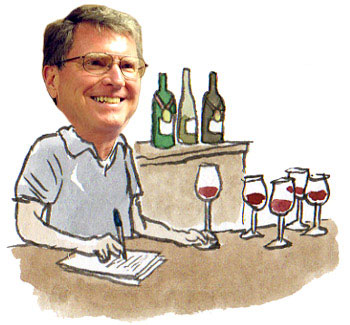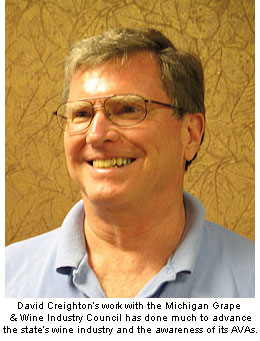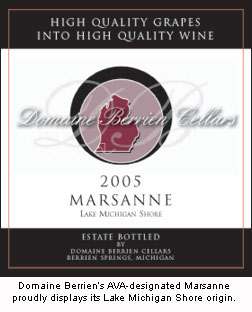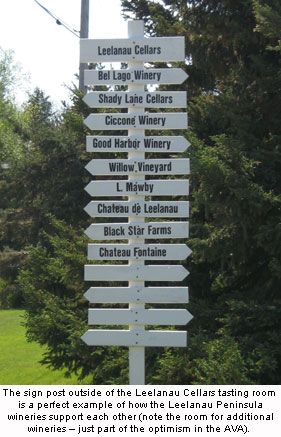

David Creighton’s work to market Michigan wine
has led to stronger regional identities for each of the state’s four AVAs.
Astute marketing moves Michigan's wines ahead
“Initially, the [Michigan Grape & Wine Industry] Council moved to promote a generic Michigan wine experience and it has now chosen to identify a distinctive experience that people have when they visit each of the appellations.”
~ David Creighton, Promotion Specialist, MGWIC
by
Eleanor & Ray Heald
September 18, 2006
Eleanor & Ray Heald (ERH): What are the specific duties of the Promotion Specialist, which is the job title you hold in the Michigan Grape & Wine Industry Council?
 Dave Creighton (DC): When I took the job in 1996, I was hired specifically to sell Michigan wines by talking to retailers, restaurateurs and sales staff. Five years ago, the Council decided that they wished me to make sure Michigan wines were part of public events, to work those promotional events and to assist the media.
Dave Creighton (DC): When I took the job in 1996, I was hired specifically to sell Michigan wines by talking to retailers, restaurateurs and sales staff. Five years ago, the Council decided that they wished me to make sure Michigan wines were part of public events, to work those promotional events and to assist the media.
Additionally, I work on organizing the annual Michigan Wine & Spirits Competition to ensure its credibility. This is crucial because the Council believes that the credibility of Michigan wines hangs, at least partly, on the competition's integrity. We've made a concerted effort to improve both the competition's organization and the experience of the judges chosen.
Five years ago, I developed the class entry system which is now used for the Michigan wine competition and it's entirely different from those used by other competitions. It allows us to serve wines to judges in the correct tasting order. Formerly, we might have, as an example, presented Vidal Ice Wine to judges followed by a [dry] Pinot Gris.
ERH: Within the realm of your duties, how do you promote each Michigan AVA, so that consumers learn the differences, well beyond addressing the wines simply as "Michigan wines?"
DC: In many ways, promoting Lake Michigan Shore AVA is most important. Consumers in southeast Michigan [metro-Detroit area] consider Michigan wine country as the Traverse City area. Until recently, the Council took the position that its job was to promote the State's wines as a whole. And it's the individual "trails" [group of wineries that organize to conduct events and promotions together] that are responsible for promotion of their specific appellation.
 A Michigan "trail" is not co-extensive with an appellation or wineries in that appellation. [Yet, on its website, the Southwest Michigan Wine Trail, with the moniker “The Other West Coast!”, clearly identifies itself with the Lake Michigan Shore AVA.]
A Michigan "trail" is not co-extensive with an appellation or wineries in that appellation. [Yet, on its website, the Southwest Michigan Wine Trail, with the moniker “The Other West Coast!”, clearly identifies itself with the Lake Michigan Shore AVA.]
Now, when I'm conducting an event, I make sure that I have representation from all of Michigan's AVAs. It's not necessarily equal because that depends on the nature of the event and which vintners may be available to attend.
ERH: Over your tenure, how have you chosen the wines you market? Let's start with Lake Michigan Shore.
DC: The way that I aid in the promotion of all Michigan wines, including wines from specific regions, is to pick the very best quality wines to showcase the appellation. So whether it's using Wyncroft, Tabor Hill, Lemon Creek, Round Barn, Domaine Berrien or St. Julian in the Lake Michigan Shore AVA, the chosen winery has a wine that fits the circumstance or necessity of the situation and is a quality wine as determined by medals in competitions, or simply the fact that I've tasted it and consider it worthy of showcasing.
I believe that the way to make a presentation and elevate consumer impression of Michigan wines is to serve the best.
 ERH: And Leelanau Peninsula?
ERH: And Leelanau Peninsula?
DC: In this AVA, wineries help each other to become better because they know that each is only as good as the weakest one. Each month, the wineries get together and taste a particular varietal wine and literally beat each other up over quality. But, at the same time, they also help each other.
Having 15 wineries in the AVA now, adds to overall strength. Every time a new winery opens, the business at all the wineries increases. It's common for tasting room staff to ask a visitor if they've visited other area wineries and if they need suggestions or help with directions. The main growth on Leelanau is due to this sort of regional promotion.
Essentially for the wine tourist who wants one stop wine shopping, Leelanau is the place. Twelve wineries are members of the Leelanau Peninsula vintners trail.
ERH: Old Mission Peninsula?
DC: The wineries of Old Mission Peninsula are more individual and each winery is committed to appellation labeling of its wines. New wineries cannot open in the appellation unless they have a source for grapes from within the appellation.
Black Star Farms, which is located in the Leelanau Peninsula AVA, labels many of its wines Old Mission Peninsula because several Black Star partners own vineyards on Old Mission.
ERH: How do you view progress and consumer understanding of wines from the Fennville AVA?
DC: New plantings by Dan Nitz in the Fennville AVA are exciting and will bring this AVA nearly instant attention.
[In Spring 2006, Dan Nitz, owner of Arrowhead Vineyards in Baroda, Mich., planted 25 acres of vines. Reds varieties – Cabernet Franc, Pinot Noir, Merlot and Cabernet Sauvignon – were planted on south facing slopes with whites on north facing slopes, including Riesling, Pinot Gris, Pinot Blanc, Chardonnay and Gewurztraminer. Near the end
 Dave Creighton (DC): When I took the job in 1996, I was hired specifically to sell Michigan wines by talking to retailers, restaurateurs and sales staff. Five years ago, the Council decided that they wished me to make sure Michigan wines were part of public events, to work those promotional events and to assist the media.
Dave Creighton (DC): When I took the job in 1996, I was hired specifically to sell Michigan wines by talking to retailers, restaurateurs and sales staff. Five years ago, the Council decided that they wished me to make sure Michigan wines were part of public events, to work those promotional events and to assist the media.Additionally, I work on organizing the annual Michigan Wine & Spirits Competition to ensure its credibility. This is crucial because the Council believes that the credibility of Michigan wines hangs, at least partly, on the competition's integrity. We've made a concerted effort to improve both the competition's organization and the experience of the judges chosen.
Five years ago, I developed the class entry system which is now used for the Michigan wine competition and it's entirely different from those used by other competitions. It allows us to serve wines to judges in the correct tasting order. Formerly, we might have, as an example, presented Vidal Ice Wine to judges followed by a [dry] Pinot Gris.
ERH: Within the realm of your duties, how do you promote each Michigan AVA, so that consumers learn the differences, well beyond addressing the wines simply as "Michigan wines?"
DC: In many ways, promoting Lake Michigan Shore AVA is most important. Consumers in southeast Michigan [metro-Detroit area] consider Michigan wine country as the Traverse City area. Until recently, the Council took the position that its job was to promote the State's wines as a whole. And it's the individual "trails" [group of wineries that organize to conduct events and promotions together] that are responsible for promotion of their specific appellation.
 A Michigan "trail" is not co-extensive with an appellation or wineries in that appellation. [Yet, on its website, the Southwest Michigan Wine Trail, with the moniker “The Other West Coast!”, clearly identifies itself with the Lake Michigan Shore AVA.]
A Michigan "trail" is not co-extensive with an appellation or wineries in that appellation. [Yet, on its website, the Southwest Michigan Wine Trail, with the moniker “The Other West Coast!”, clearly identifies itself with the Lake Michigan Shore AVA.]Now, when I'm conducting an event, I make sure that I have representation from all of Michigan's AVAs. It's not necessarily equal because that depends on the nature of the event and which vintners may be available to attend.
ERH: Over your tenure, how have you chosen the wines you market? Let's start with Lake Michigan Shore.
DC: The way that I aid in the promotion of all Michigan wines, including wines from specific regions, is to pick the very best quality wines to showcase the appellation. So whether it's using Wyncroft, Tabor Hill, Lemon Creek, Round Barn, Domaine Berrien or St. Julian in the Lake Michigan Shore AVA, the chosen winery has a wine that fits the circumstance or necessity of the situation and is a quality wine as determined by medals in competitions, or simply the fact that I've tasted it and consider it worthy of showcasing.
I believe that the way to make a presentation and elevate consumer impression of Michigan wines is to serve the best.
 ERH: And Leelanau Peninsula?
ERH: And Leelanau Peninsula?DC: In this AVA, wineries help each other to become better because they know that each is only as good as the weakest one. Each month, the wineries get together and taste a particular varietal wine and literally beat each other up over quality. But, at the same time, they also help each other.
Having 15 wineries in the AVA now, adds to overall strength. Every time a new winery opens, the business at all the wineries increases. It's common for tasting room staff to ask a visitor if they've visited other area wineries and if they need suggestions or help with directions. The main growth on Leelanau is due to this sort of regional promotion.
Essentially for the wine tourist who wants one stop wine shopping, Leelanau is the place. Twelve wineries are members of the Leelanau Peninsula vintners trail.
ERH: Old Mission Peninsula?
DC: The wineries of Old Mission Peninsula are more individual and each winery is committed to appellation labeling of its wines. New wineries cannot open in the appellation unless they have a source for grapes from within the appellation.
Black Star Farms, which is located in the Leelanau Peninsula AVA, labels many of its wines Old Mission Peninsula because several Black Star partners own vineyards on Old Mission.
ERH: How do you view progress and consumer understanding of wines from the Fennville AVA?
DC: New plantings by Dan Nitz in the Fennville AVA are exciting and will bring this AVA nearly instant attention.
[In Spring 2006, Dan Nitz, owner of Arrowhead Vineyards in Baroda, Mich., planted 25 acres of vines. Reds varieties – Cabernet Franc, Pinot Noir, Merlot and Cabernet Sauvignon – were planted on south facing slopes with whites on north facing slopes, including Riesling, Pinot Gris, Pinot Blanc, Chardonnay and Gewurztraminer. Near the end















